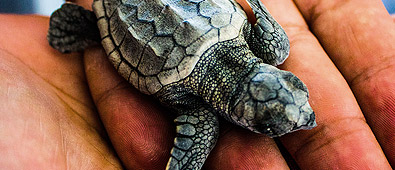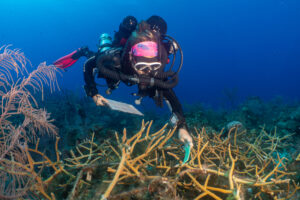 As habitat complexity degrades, it is important to find means of intervention that can re-create the three-dimensional structure of coral reefs in order to sustain fish populations. This project seeks to understand the impacts of coral restoration out-planting, used as a mechanism to increase reef complexity, on the abundance and diversity of fish populations all the way up the food chain. Ultimately, results of this work could help determine if we can re-create complex reef systems that promote sustainable populations of commercially important fish species. Importantly, if successful this could be used as a mechanism to restore sites where commercially important fish stocks have declined.
As habitat complexity degrades, it is important to find means of intervention that can re-create the three-dimensional structure of coral reefs in order to sustain fish populations. This project seeks to understand the impacts of coral restoration out-planting, used as a mechanism to increase reef complexity, on the abundance and diversity of fish populations all the way up the food chain. Ultimately, results of this work could help determine if we can re-create complex reef systems that promote sustainable populations of commercially important fish species. Importantly, if successful this could be used as a mechanism to restore sites where commercially important fish stocks have declined.
Past Research

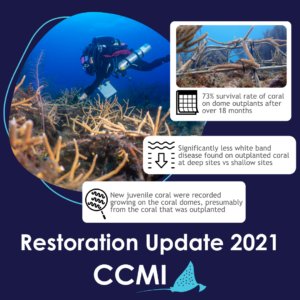 The success of coral out-planting from nurseries in the Caribbean has varied widely. Previous work at CCMI has shown that fragments of staghorn corals from our nurseries have a higher survival rate when elevated off the benthos onto three-dimensional structures. This study seeks to further our understanding of out-plant success by examining how the depth of the out-planting site impact growth and survival on these three-dimensional structures. The information gained from this project will be use to scale-up our out-planting and restoration strategies and can inform regional and international restoration efforts. Learn more about this project and CCMI’s coral restoration work HERE.
The success of coral out-planting from nurseries in the Caribbean has varied widely. Previous work at CCMI has shown that fragments of staghorn corals from our nurseries have a higher survival rate when elevated off the benthos onto three-dimensional structures. This study seeks to further our understanding of out-plant success by examining how the depth of the out-planting site impact growth and survival on these three-dimensional structures. The information gained from this project will be use to scale-up our out-planting and restoration strategies and can inform regional and international restoration efforts. Learn more about this project and CCMI’s coral restoration work HERE.
 Restoration activities at CCMI have documented differences in the response of individuals to disease outbreaks and heat stress events, either through genetics or plasticity. Through our understanding of disease resistance and heat tolerance we will assist the evolution of the Acroporid populations by selecting for the most tolerant individuals that will then be used to restore nearshore coral reef sites, creating reefs with higher tolerance to the main threats affecting corals. This project, therefore, will promote local reef resilience and sustain biodiversity and ensure the persistence of reefs into the foreseeable future in the Cayman Islands. Learn more about this project and CCMI’s coral restoration work HERE.
Restoration activities at CCMI have documented differences in the response of individuals to disease outbreaks and heat stress events, either through genetics or plasticity. Through our understanding of disease resistance and heat tolerance we will assist the evolution of the Acroporid populations by selecting for the most tolerant individuals that will then be used to restore nearshore coral reef sites, creating reefs with higher tolerance to the main threats affecting corals. This project, therefore, will promote local reef resilience and sustain biodiversity and ensure the persistence of reefs into the foreseeable future in the Cayman Islands. Learn more about this project and CCMI’s coral restoration work HERE.
 This 18-month study led by CCMI Researcher Dr. Alli Candelmo used the most current telemetry technologies to track the movement patterns of lionfish (Pterois volitans) along the reefs in Little Cayman. The project was seeking new ways to limit the ecological and economic impacts of lionfish both locally and regionally by utilizing novel advances in acoustic telemetry to increase the understanding of movement patterns of lionfish.
This 18-month study led by CCMI Researcher Dr. Alli Candelmo used the most current telemetry technologies to track the movement patterns of lionfish (Pterois volitans) along the reefs in Little Cayman. The project was seeking new ways to limit the ecological and economic impacts of lionfish both locally and regionally by utilizing novel advances in acoustic telemetry to increase the understanding of movement patterns of lionfish.
Acoustically coded transmitters will be deployed to assess spatial and temporal patterns of the lionfish’s horizontal movement. This will include the tracking of routine (daily, monthly, seasonal) vertical migrations between shallow and deep reef habitats and environmental and insight into biological cues which may motivate these movement patterns. Information obtained from this study will be applicable to more effective site selection for targeted removal efforts. A principal output from this project will be the creation of a publicly accessible database and map of the lionfish population in Little Cayman, which help cullers select appropriate times and locations for removal efforts and thereby result in optimal protection of coral reef biodiversity from this immediate invasive threat.
This project builds on CCMI’s research into the invasive species which established in 2009. Since 2012 CCMI has worked with the local community to maintain three experimental and three control (unculled) sites to understand the impact of culling. These sites and the ongoing work provide important information about the population dynamics and behaviour patterns of lionfish that can be applied to develop informed resource management strategies.
A grant of 99,880.17 Euros was awarded by the European Union’s BEST 2.0 programme to improve the management of the invasive lionfish. The project is also supported by the Guy Harvey Ocean Fund.
To see how culling is working in Little Cayman and to make a difference to this project, please CLICK HERE to see our maps and resources.
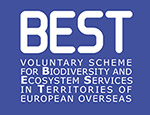
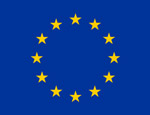
This document has been produced with the financial assistance of the European Union. The contents of this document are the sole responsibility of CCMI and can under no circumstances be regarded as reflecting the position of the European Union.
Herbivorous Fish: Key to Coral Reef Health in the Caribbean
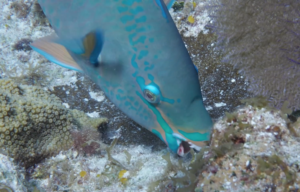
Photo courtesy Claire Fletcher
Coral reef health relies on dynamic interactions among key functional groups of organisms. Disruptions to the roles these taxa play (fish, coral and algae) can lead to changes in community structure with negative implications for coral reef biodiversity. Algae is an important food source in reef systems, but it is an excellent competitor to corals and can compromise coral larval recruitment. It has overtaken corals on many reefs, and this phase-shift from coral to algal dominated systems is problematic for the functioning of the reef system and for the people who rely on it.
Herbivorous fish keep algae in check so that corals can grow and reproduce, and this helps to keep the system in balance. This project will identify functionally important herbivores that maintain the balance between algae and corals. The outcomes will help us to understand which herbivorous species make the biggest contribution to the reefs of the Cayman Islands and how we can protect them.
This project is investigating the characteristics of herbivorous fish across all three of the Cayman Islands. This includes understanding their abundance, distribution, their diet preferences and their population connectivity in the local reef ecosystem. We are also seeking to understand the pressures these populations face, so that we can create a comprehensive biodiversity action plan that can be of use to the national government in managing these critical species.
This project has been integral in the development of education modules which are shared with education groups visiting CCMI’s Little Cayman Research Centre, with classrooms throughout the Cayman Islands and with an international audience. Relevant teacher resources including videos, fact sheets, activity sheets, lesson plans and lesson slide decks are available freely on our website.
The project is supported by Darwin Plus Initiative, which provides grants for UK overseas territories that are rich in biodiversity, Alexandra Bancorp Limited, the Smithsonian, the Cayman Islands Department of Environment and private donors that support CCMI.
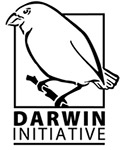

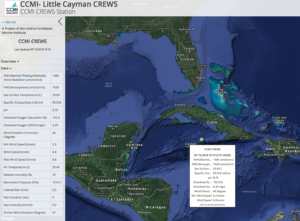 The CREWS provides CCMI with the opportunity to be at the forefront of coral reef science because it offers near real time information on the ocean environment around the robust reefs of Little Cayman. The project is led by the United States National Oceanographic and Atmospheric Administration (NOAA). CREWS gets its name from its success in modelling and alerting impacts on coral reefs from climate-related events such as, coral bleaching, seasonal upwelling, or approaching storms. This system is considered part of a NOAA Integrated Coral Observing Network (ICON) and is thus named ICON/CREWS.
The CREWS provides CCMI with the opportunity to be at the forefront of coral reef science because it offers near real time information on the ocean environment around the robust reefs of Little Cayman. The project is led by the United States National Oceanographic and Atmospheric Administration (NOAA). CREWS gets its name from its success in modelling and alerting impacts on coral reefs from climate-related events such as, coral bleaching, seasonal upwelling, or approaching storms. This system is considered part of a NOAA Integrated Coral Observing Network (ICON) and is thus named ICON/CREWS.
The CREWS buoy system uses local information about weather and marine conditions that is continually gathered by a series of monitoring stations and buoys located across the Caribbean Sea as well as worldwide. The data is transmitted in real-time to NOAA for integration and analysis, while also being made available online to researchers, policy-makers, and to the public. ICON uses the data collected by CREWS in conjunction with satellite data and radar technologies to analyse and forecast regional oceanographic and atmospheric trends. The CREWS system has been successfully used in modeling and alerts of coral bleaching conditions both locally in the Cayman Islands and the Caribbean Sea. Over time, it is NOAA’s intent to expand the CREWS system by installing stations in more geographic regions and to further refine the systems capability to better predict the impact of climate patterns on coral reefs.
Originally installed in 2009, this monitoring location gave CCMI, the Cayman Islands, and the general public access to real-time weather information and records of local climate patterns over time. In October 2012, Hurricane Sandy unfortunately damaged CCMI’s monitoring system beyond repair. Almost one year later, a more rugged and robust monitoring buoy was installed in its place and remained in place until 2017, when recurring communications issues required it to be replaced.
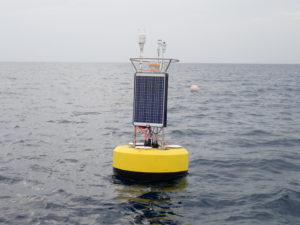
OLYMPUS DIGITAL CAMERA
In June 2018, CCMI installed a new, modern, state-of-the-art oceanographic buoy on the north side of Little Cayman, thanks to funding provided by the Dart Foundation and the Edmund F. and Virginia B. Ball Foundation. Near real-time weather and ocean state information will be easily accessible from a mobile phone or computer. It contains a weather system and instruments to measure light (photosynthetically active radiation- PAR) and 5 instruments underwater measuring light (PAR), dissolved oxygen, conductivity (salinity), temperature, and pH. This is the first time that we are able to test for changes in the acidification of the seas surrounding Little Cayman. Ocean acidification is a major threat to biodiversity and has been linked to lower calcification rates in skeletal organisms and poor larval development. The new CREWS includes an Acoustic Doppler Current Profiler (ADCP) which will measure the movement of water traveling across the reef system. Understanding currents will help direct future work to understand the replenishment of fish and corals as they spawn near our marine protected areas.
Current conditions are available to view online and via mobile app. For information on how to access historical and detailed data from the CREWS buoy, send us an email.


